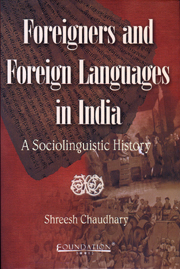Book contents
- Frontmatter
- Contents
- List of Annexes
- Notation Used for Transcribing Non-English Words, Names, Etc.
- Foreword
- Preface
- Acknowledgements
- 1 Introduction
- 2 Greek, Hebrew and Sanskrit
- 3 Arabic, Persian and Turkish
- 4 Armenian, Portuguese, Dutch and French
- 5 East India Company and The Indian Languages
- 6 East India Company and The English Language
- 7 Conclusion
- Index
Preface
Published online by Cambridge University Press: 26 October 2011
- Frontmatter
- Contents
- List of Annexes
- Notation Used for Transcribing Non-English Words, Names, Etc.
- Foreword
- Preface
- Acknowledgements
- 1 Introduction
- 2 Greek, Hebrew and Sanskrit
- 3 Arabic, Persian and Turkish
- 4 Armenian, Portuguese, Dutch and French
- 5 East India Company and The Indian Languages
- 6 East India Company and The English Language
- 7 Conclusion
- Index
Summary
In his book on language contact in India, Shreesh Chaudhary provides an entertaining description of how India has received numerous non-Indian languages during the last few centuries. This account is meant for the general reader.
Theoretical linguists like me are prone to seeing each and every detail of a language contact description as a datum to be used for the refinement or revision of existing theories of language contact or for the construction of a new theory of that field or of language in general. The sonority-sensitive use of prothesis and epenthesis by speakers of Hindi faced with ‘illegal’ word-initial English consonantal clusters led me almost a quarter of a century ago to argue for the abandonment of the formalist mechanism called ‘phonological rule’. We tend to forget that the enterprise of theory construction, though entirely valid and fascinating, ignores the educated lay person, who would rather get the whole ‘who done it’ without worrying too much about the model of the gun used to fire the fatal shot.
Chaudhary attempts to provide a full, minimally technical, account of what has happened to numerous foreign languages that have entered the mathetic landscape of India during the last few centuries, concentrating on Sanskrit, Persian, Portuguese, and English.
- Type
- Chapter
- Information
- Foreigners and Foreign Languages in IndiaA Sociolinguistic History, pp. ix - xPublisher: Foundation BooksPrint publication year: 2008

